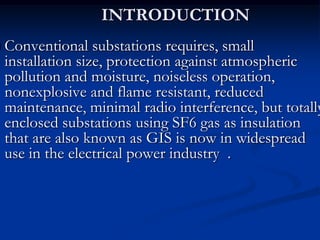
Gagan
- 1. INTRODUCTION Conventional substations requires, small installation size, protection against atmospheric pollution and moisture, noiseless operation, nonexplosive and flame resistant, reduced maintenance, minimal radio interference, but totally enclosed substations using SF6 gas as insulation that are also known as GIS is now in widespread use in the electrical power industry .
- 2. It consist of • Bus bars • Circuit breakers • Disconnecting switches • Earthing switches • Current transformers • Voltage transformers • Densimeter • Cable and boxes • Gas supply and gas monitoring equipment • Local control
- 3. Circuit Breaker Under short circuit conditions, however, the current may reach tens of thousands of amperes at a power factor as low as 0.1. It is duty of a circuit breaker to interrupt such currents as soon as possible to avoid equipment damage.
- 4. Disconnectors •Disconnectors or isolators are used for electrical isolation of circuit parts •They are slow acting and operating at off load •Disconnectors must be carefully designed and tested to be able to break small charging current without generating too-high over voltage,
- 5. Local Control Cubicles “LCC” LCC is the interface cubicles to all secondary systems of a substation which are represent a station control and protection. LCC includes control and alarm functions as well as the correct distribution of auxiliary power supply for the relevant GIS bay.
- 6. Earthing Switch Slow-operating earthing switch are used for protection purpose when work is being done in the substation, but are operated only when it is certain that the high-voltage system is not energized. The fast-closing earthing switch can close against full voltage and short circuit power. The high speed earthing switch is achieved by means of a spring-closing device.
- 7. Voltage Transformer Variable location on feeder and busbars. Integrated disconnecting facility for GIS and power cable testing without dismantling and gas handling. Flexible gas compartment allocation for optimal service oriented gas supervision.
- 8. Current Transformer the single phase in enclosed Core of CT is located outside the enclosure$inside for three phase Gas compartment to reduce access of moisture and to suppress gas-tight bushings for secondary connections.
- 9. Cables Compartment 1.Optimized solution for plug-in type power cable connection. 2. Adjustable support structures for minimum requirements for the GIS floor. 3. Fixation to the GIS floor by cemented anchor bolts, no need for special foundation (steel beams….etc)
- 10. PROPERTIES OF SF6 • SF6 does not harm to the ozone layer. • Sf6 gas is chemically stable • Non poisonous • Colourless&heavier than air • Almost water insoluble • Non inflammable
- 11. ADVANTAGES • Gis have no risks for fire&explosion due to leakage of oil • They generate no noise&have no radio interference • Located closure to load centers there by reducing transmission&distribution sms • It offer solutions including -In industrial areas where space&pollution problems -Mountain areas where ice&snow are major problems
- 12. DISADVANTAGES GIS installations tend to be much more expensive that air-insulated installations with the same rating. VFTO during switching operations or earth faults and transient enclosure voltages and particle contamination
- 13. APPLICATIONS • High voltage installations (above 115kv) • Urban installations • Indoor installations
- 15. LAY OUT OF GIS
- 16. GAS INSULATED TRANSFORMER Use SF6 Gas as the insulating and cooling medium instead of insulating oil. First units produced in 1967. Transformer applications: Distribution class units up to 400 MVA, 345 kV. •Primarily used in substations located in urban areas (including inside buildings, underground) due to safety benefits.
- 17. GAS INSULATED SWITCH GEAR The space occupied by switch gear is greatly reduced Totally unaffected by atmospheric conditions Provides high degree of operational reliability Easier to install in difficult site conditions
- 18. GAS INSULATED SHUNT REACTOR Features • Suitable for installation • Excellent history of reliability and safety • Fine radial core • Circular yoke and circular tank • Low loss • Easy maintenance Manufacturing Range • Voltage-13.8 ~ 138kV • Frequency-50 or 60Hz • Capacity-5 ~ 60Mvar
- 19. FUTURE TRENDS IN GAS INSULATED SUBSTATIONS Compact design of switch gear by using three phase modules Use of vacuum circuit breaker cells in the medium high voltage GIS and fewer brakes per pole in high voltage circuit breakers Optimization of GIS design to allow easier maintenance
- 20. CONCLUSION GIS are necessary for EHV&UHV and some important areas to be studied include more conservative designs better particle control&improved gas handling&decomposition product management techniques Achieving&maintaining high levels of availability requires a more integrated approach to quality control by both users and manufactures